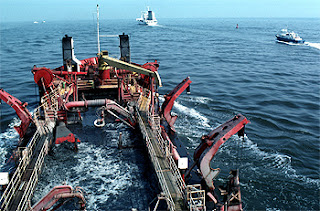 As an alternative, non-invasive (non-wetted) flow meters, such as clamp-on or Doppler ultrasonic flow meters, have long been proposed because of their ease of installation and maintenance savings. However, testing of clamp-on or Doppler ultrasonic flow meters has never panned out in dredging applications. While there has been limited success on smaller sized diameters, there are few, if any, large diameter dredging pipe application success stories.
As an alternative, non-invasive (non-wetted) flow meters, such as clamp-on or Doppler ultrasonic flow meters, have long been proposed because of their ease of installation and maintenance savings. However, testing of clamp-on or Doppler ultrasonic flow meters has never panned out in dredging applications. While there has been limited success on smaller sized diameters, there are few, if any, large diameter dredging pipe application success stories.Dredging engineers always seek the simplest and most accurate method of measuring slurry flow. Considering this, there is convincing evidence that the use of customized electromagnetic flow meters, specifically designed to stand up to the rigors of dredging, look to be the best overall option.
 |
| Dredging flow meter. (TECO) |
The dredging modifications include custom engineered ceramic brick or polyurethane liners, 3/4" stainless steel inlet and outlet protectors, independently sealed electrode wells, and field accessible Hastelloy B electrodes.
Thompson Equipment (TECO), a manufacturer of severe service magnetic flow meters located in New Orleans, will "remanufacture" any make or model of electromagnetic flow meter for dredging service. They have decades of experience servicing and remanufacturing instrumentation, and are leaders in building severe service flow meters.
Electromagnetic flow meters have always been appealing for dredging applications in terms of accuracy, resolution, and response time. Their performance problems, caused by the direct and continuous flow of abrasive slurries, are mitigated through specialized construction. By applying electromagnetic flow meters specifically designed for the application, dredging engineers now achieve excellent reliability, long life and significant reduction in maintenance and operational costs.




